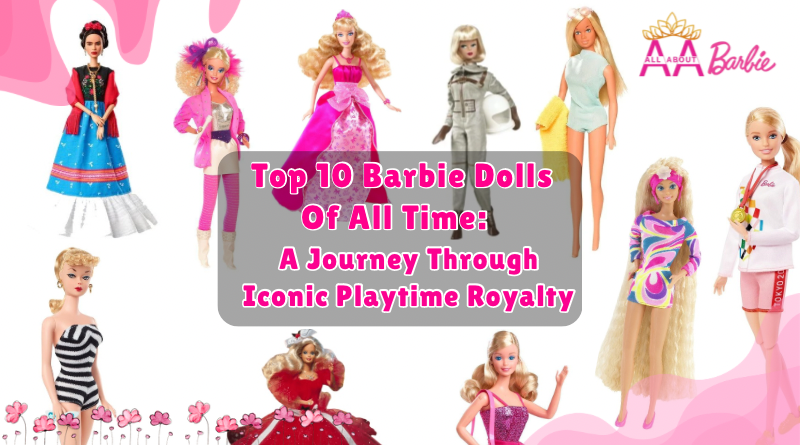Barbie. She’s been a superstar, a doctor, an astronaut, and pretty much everything in between. But before she was any of these, she was a symbol of fun, fashion, and freedom for a generation discovering its voice. When it comes to Barbie history, there’s something magical about the 1960s.
This era wasn’t just about glamorous clothes and bouffant hairstyles; it was a time of incredible social change, and Barbie was right there, adapting with each shift and inspiring her fans to dream big. Let’s step back in time to uncover how Barbie became a true icon of the 1960s.
The Birth of a 60’s Icon
Introduced in 1959, Barbie was a revelation in toy aisles, and she only became more captivating as she sashayed her way into the 60s. Back then, Barbie was the brainchild of Ruth Handler, co-founder of Mattel. Handler noticed her daughter Barbara’s fascination with paper dolls, inspiring her to create a three-dimensional doll that would allow girls to dream up their futures.
Handler’s vision came to life in 1959, but the 1960s were the years when Barbie truly flourished. By embodying the cultural changes and diverse new fashions of the time, she quickly went from toy to icon, reflecting the evolving spirit of a world ready for fresh, bold perspectives.
Fashion Through the Decades: The Evolution of Barbie’s Style
If the 60s were famous for anything, it was fashion, and Barbie’s wardrobe was always a step ahead. Each year, new designs rolled out, capturing the essence of the decade. Here are a few unforgettable looks:
- 1961 – Bubble-Cut Barbie: The 1961 Barbie sported a chic bubble-cut hairstyle—a nod to the fashionable bouffants of the era. This doll was also the first to sport “real” clothes, like tailored suits and ladylike dresses, signaling that Barbie was growing up alongside her fans.
- 1962 – The Sophisticated Evening Gala Barbie: As the glamour of Hollywood made its way into the culture, Barbie joined in with beautiful evening gowns, like the “Red Flare” outfit. Complete with a red silk gown and a fur stole, she was all about sophistication.
- 1965 – Barbie Goes Mod: By the mid-60s, Barbie was breaking new fashion ground. The Mod look, full of bright colors, geometric prints, and edgy hemlines, made its way into her closet. Barbie’s outfits echoed the London “Mod” scene, with miniskirts, knee-high boots, and daring prints, letting fans channel the vibe of trendy British icons like Twiggy.
Iconic Careers of the 60s Barbie
While Barbie’s look captured the stylish times, her career options reflected a changing world where women were exploring new possibilities. The 1960s was the era when Barbie’s careers went beyond just looks:
- 1961 – Registered Nurse Barbie: This was Barbie’s first serious job, and she came equipped with all the necessary nursing accessories, complete with a stylish little hat. She was every bit the working woman, showing young girls they could care for others and be professionals, too.
- 1965 – Astronaut Barbie: Way before women were actively working in NASA, Barbie was donning a spacesuit and heading to the stars. In a world still captivated by the Space Race, Barbie encouraged girls to think beyond earthly boundaries and dream as high as the moon!
- 1968 – Barbie Learns About Social Work: As the decade neared its end, social issues were taking center stage, and Barbie was once again a reflection of her time. This career shift reflected the compassion emerging within society and a call for women to help change their communities.
Barbie’s Friends and Family: Expanding the Barbieverse
Barbie’s world expanded significantly in the 1960s, with friends and family members who made her universe feel more relatable.
- Ken – The Ultimate Heartthrob: Ken made his debut in 1961, and the two were an instant match. With his California tan and killer style, Ken became the classic “boy next door,” bringing more fun and adventure to Barbie’s world.
- Midge – The Best Friend: In 1963, Midge made her entrance as Barbie’s best friend. With her freckled face and wholesome style, Midge was down-to-earth and relatable, offering a contrast to Barbie’s high glamour.
- Skipper – The Little Sister: In 1964, Mattel introduced Skipper, Barbie’s little sister. She allowed young fans to explore the dynamics of family life, giving Barbie a more grounded, everyday role as a big sister.
Reflecting Social Change
The 1960s were all about social change. With the Civil Rights Movement, second-wave feminism, and a rise in social consciousness, the era called for a doll that could grow with the world.
- Barbie and Representation: The late 60s brought the first African American dolls into Barbie’s world, although these dolls were marketed as friends, not Barbie herself. In 1968, Christie was introduced—a groundbreaking addition to Barbie’s friend group, she represented a pivotal moment for diversity and inclusion in the toy industry.
- Fashion Queen Barbie: Barbie also played into the era’s growing emphasis on self-expression. With the “Fashion Queen” Barbie, girls could switch up Barbie’s hairstyles with wigs, encouraging playfulness and creativity.
Cultural Influence: Barbie in Film, TV, and Music
Barbie didn’t just stay on store shelves; she became a cultural phenomenon. She made appearances on TV, was featured in comic books, and even inspired a host of catchy tunes. Throughout the 60s, Barbie’s image was everywhere. In many ways, she was more than a doll; she was an icon, making it possible for girls to see themselves in someone confident, stylish, and aspirational.
The Impact of 60s Barbie on Modern Collectors
Today, 60s Barbie dolls are prized items among collectors. Vintage Barbies, especially those from the early 1960s, are in high demand, with many selling for hundreds or even thousands of dollars. Their outfits, accessories, and hairstyles remain a snapshot of a time when fashion was bold, and Barbie’s influence was unstoppable.
For collectors, these dolls are treasured because they represent more than just toys; they’re pieces of history. Many vintage Barbies still carry the marks of the unique changes in plastic and fabric styles from the time, and with their iconic packaging and original outfits, they’re a beautiful reminder of how Barbie helped shape popular culture.
The Legacy of 60s Barbie in Modern Dolls
Even after more than six decades, the spirit of the 1960s Barbie lives on. Mattel has re-released many of Barbie’s iconic looks from the 60s, and her retro outfits are still admired by fans. New dolls continue to take inspiration from her Mod looks and stylishly fearless attitude. Every new Barbie carries a bit of that original “anything is possible” spark, a philosophy that continues to inspire generations.
Barbie’s 60s era isn’t just about fashion—it’s about changing perspectives, bold dreams, and empowering girls to break barriers. As we look back on the 1960s, Barbie stands as a true icon, symbolizing a spirit of adventure, fun, and possibility. Whether you’re a lifelong fan or just discovering the world of vintage Barbie, the 60s is a great era to fall in love with, offering not just nostalgia but a timeless reminder that Barbie’s world is a space for dreaming big, dressing up, and exploring every side of who you can be.
Wrapping Up Our Trip Through the 1960s Barbie Era
The 1960s Barbie isn’t just a toy; she’s a legend who reflects a pivotal era in American history and culture. From the height of fashion to breaking boundaries in careers, Barbie was, and still is, a symbol of empowerment and creativity. She reminds us that toys can be more than entertainment—they can inspire, reflect, and even spark change.
So, here’s to 60s Barbie: the doll that reminded girls everywhere to be stylish, adventurous, and unafraid to dream big. Whether you’re a collector or a fan, we hope this journey down memory lane has inspired you to see Barbie in a whole new light. Embrace the fun, keep exploring, and remember, with Barbie, anything is possible!

